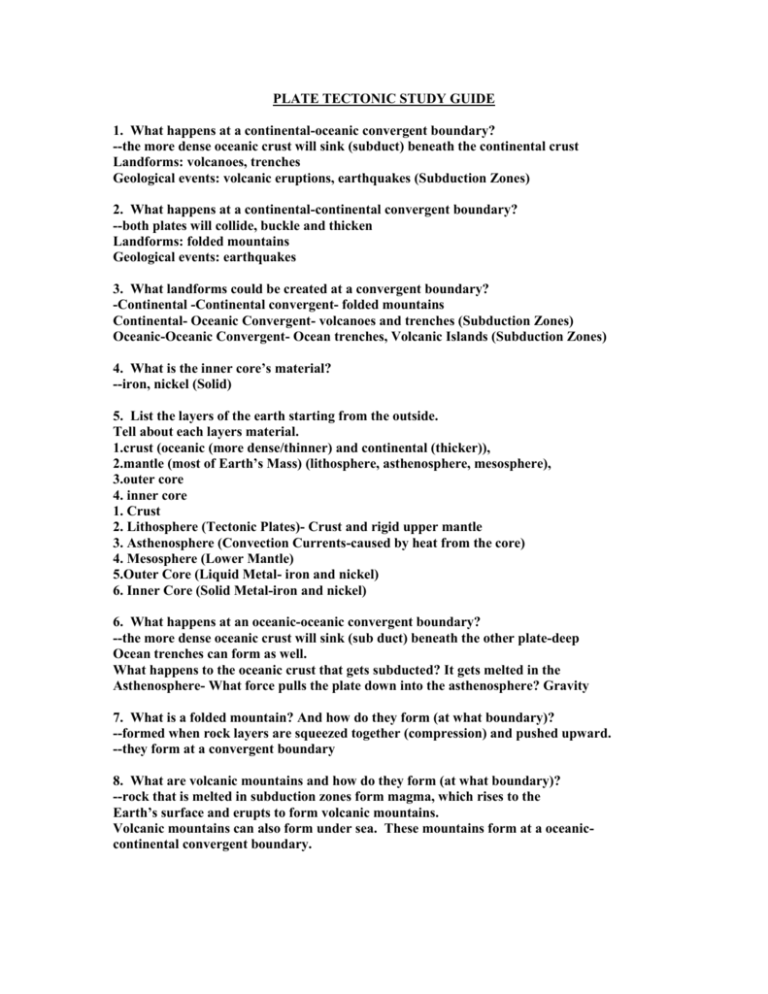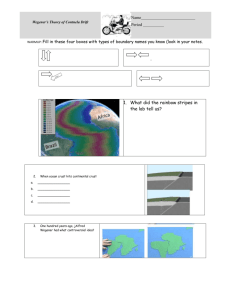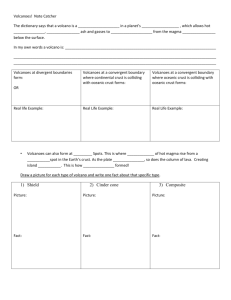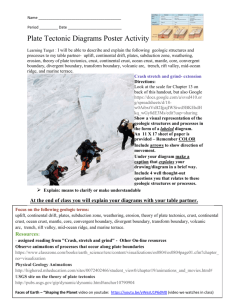plate tectonic study guide
advertisement

PLATE TECTONIC STUDY GUIDE 1. What happens at a continental-oceanic convergent boundary? --the more dense oceanic crust will sink (subduct) beneath the continental crust Landforms: volcanoes, trenches Geological events: volcanic eruptions, earthquakes (Subduction Zones) 2. What happens at a continental-continental convergent boundary? --both plates will collide, buckle and thicken Landforms: folded mountains Geological events: earthquakes 3. What landforms could be created at a convergent boundary? -Continental -Continental convergent- folded mountains Continental- Oceanic Convergent- volcanoes and trenches (Subduction Zones) Oceanic-Oceanic Convergent- Ocean trenches, Volcanic Islands (Subduction Zones) 4. What is the inner core’s material? --iron, nickel (Solid) 5. List the layers of the earth starting from the outside. Tell about each layers material. 1.crust (oceanic (more dense/thinner) and continental (thicker)), 2.mantle (most of Earth’s Mass) (lithosphere, asthenosphere, mesosphere), 3.outer core 4. inner core 1. Crust 2. Lithosphere (Tectonic Plates)- Crust and rigid upper mantle 3. Asthenosphere (Convection Currents-caused by heat from the core) 4. Mesosphere (Lower Mantle) 5.Outer Core (Liquid Metal- iron and nickel) 6. Inner Core (Solid Metal-iron and nickel) 6. What happens at an oceanic-oceanic convergent boundary? --the more dense oceanic crust will sink (sub duct) beneath the other plate-deep Ocean trenches can form as well. What happens to the oceanic crust that gets subducted? It gets melted in the Asthenosphere- What force pulls the plate down into the asthenosphere? Gravity 7. What is a folded mountain? And how do they form (at what boundary)? --formed when rock layers are squeezed together (compression) and pushed upward. --they form at a convergent boundary 8. What are volcanic mountains and how do they form (at what boundary)? --rock that is melted in subduction zones form magma, which rises to the Earth’s surface and erupts to form volcanic mountains. Volcanic mountains can also form under sea. These mountains form at a oceaniccontinental convergent boundary. 9.What are fault-block mountains and how do they form (at what boundary)? --they form when this tension causes large blocks of the Earth’s crust to drop down relative to other blocks 10. Match the boundaries with the stresses and faults. --Transform boundary—shearing stress--strike-slip fault --convergent boundary—compression stress—reverse fault --divergent boundary—tension stress—normal fault 11. Name each fault and tell about the hanging walls. --reverse fault—hanging wall goes up --normal fault—hanging wall goes down 12. List the layers of the earth from least dense to most dense. --Crust, mantle, outer core, inner core 13. What is the plate tectonic theory? --the theory that large slabs of lithospheric (tectonic plates) crust moves around on top of the asthenosphere and change the look of the earth overtime 14. Why did scientists reject Wegner’s continental drift theory? --he could not explain what force moved the lithospheric plates-he could not Explain the force that caused pangea to break-up 15. Explain the ocean floor at the mid-ocean ridge (Divergent boundary)? Tell about the age of the floor. What is the mid-ocean ridge? Longest chain of underwater Mountains (in the world) in the Atlantic ocean --the ocean floor at the mid-ocean ridge produces new oceanic crust and pushes the old crust farther away for the mid-ocean ridge as the crust moves farther from the ridge it is also becoming more dense -Sea-floor spreading is taking place at the mid-ocean ridge 16. Name some things that Wegner used to support his theory of continental drift. --mesosaurus on different continents (too small to swim in the ocean) --tropical plant fossils found in artic regions --coastlines of the continents fit together like puzzle pieces --mountain ranges on different continents lineup --coal found in artic regions --glacial grooves found in rocks in warm climates 17. What is the main force that moves the lithospheric plates? Where does this occur? --convection currents --the asthenosphere 18. Draw a picture of anticline and syncline. 19. What is the name of the supercontinent? --Pangaea (all lands or all earth) 20. What kind of crust is formed at the mid-ocean ridge (divergent boundary)? --new oceanic crust 21. Tell me everything you know about sea-floor spreading (divergent boundary). --sea-floor spreading occurs at the mid-ocean ridge. New oceanic crust is formed at the mid-ocean ridge and the old crust is pushed to the sides. The old oceanic crust continues to get more dense as it is pushed further to the sides and eventually sinks into a subduction zone. The old oceanic crust then goes to the asthenosphere where it melts and recycles back to the mid-ocean ridge. 22. Where do most faults occur? (at transform boundary- earthquakes) - a fault is a break in the Earth’s crust mainly occurs at transform boundaries -a lot of earthquakes happen at fault lines 23. What is a rift valley? At what boundaries do they occur? - is a long narrow valley that forms along divergent plate boundaries 24. What is subduction? - when two plates(oceanic-oceanic or continental-oceanic) collide (converge) together the most dense plate sinks back into the Asthenosphere and melts 25. Where does most tectonic activity (earthquakes, volcanoes, volcanic eruptions etc.) occur? Along the edges of plate boundaries






